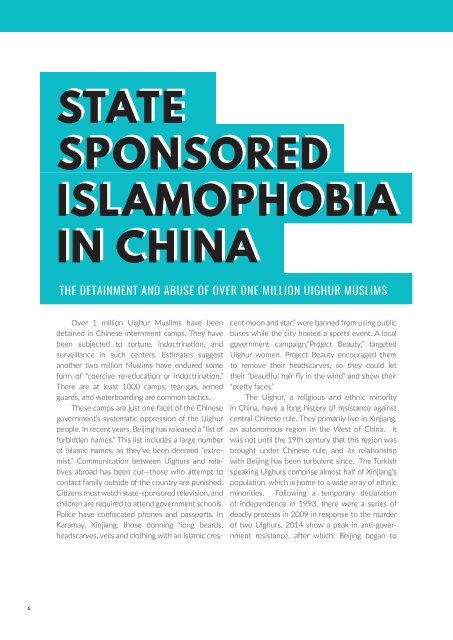Other Collective Magazine - Winter 2019
You also want an ePaper? Increase the reach of your titles
YUMPU automatically turns print PDFs into web optimized ePapers that Google loves.
STATE<br />
SPONSORED<br />
ISLAMOPHOBIA<br />
IN CHINA<br />
THE DETAINMENT AND ABUSE OF OVER ONE MILLION UIGHUR MUSLIMS<br />
Over 1 million Uighur Muslims have been<br />
detained in Chinese internment camps. They have<br />
been subjected to torture, indoctrination, and<br />
surveillance in such centers. Estimates suggest<br />
another two million Muslims have endured some<br />
form of “coercive re-education or indoctrination.”<br />
There are at least 1000 camps; tear-gas, armed<br />
guards, and waterboarding are common tactics.<br />
These camps are just one facet of the Chinese<br />
government’s systematic oppression of the Uighur<br />
people. In recent years, Beijing has released a “list of<br />
forbidden names.” This list includes a large number<br />
of Islamic names, as they’ve been deemed “extremist.”<br />
Communication between Uighurs and relatives<br />
abroad has been cut—those who attempt to<br />
contact family outside of the country are punished.<br />
Citizens must watch state-sponsored television, and<br />
children are required to attend government schools.<br />
Police have confiscated phones and passports. In<br />
Karamay, Xinjiang, those donning “long beards,<br />
headscarves, veils and clothing with an Islamic crescent<br />
moon and star,” were banned from using public<br />
buses while the city hosted a sports event. A local<br />
government campaign,“Project Beauty,” targeted<br />
Uighur women. Project Beauty encouraged them<br />
to remove their headscarves, so they could let<br />
their “beautiful hair fly in the wind” and show their<br />
“pretty faces.”<br />
The Uighur, a religious and ethnic minority<br />
in China, have a long history of resistance against<br />
central Chinese rule. They primarily live in Xinjiang,<br />
an autonomous region in the West of China. It<br />
was not until the 19th century that this region was<br />
brought under Chinese rule, and its relationship<br />
with Beijing has been turbulent since. The Turkish<br />
speaking Uighurs comprise almost half of Xinjiang's<br />
population, which is home to a wide array of ethnic<br />
minorities. Following a temporary declaration<br />
of independence in 1993, there were a series of<br />
deadly protests in 2009 in response to the murder<br />
of two Uighurs. 2014 show a peak in anti-government<br />
resistance, after which, Beijing began to<br />
6




